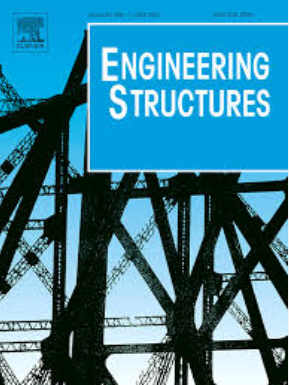Vibration isolation performance of quasi constant natural frequency isolation pads associated with test verification
IF 5.6
1区 工程技术
Q1 ENGINEERING, CIVIL
引用次数: 0
Abstract
The vibration and noise induced by the operation of subway trains cause disturbances to the adjacent building structures. The serviceability of building structures (i.e., offices and residences) in terms of the annoyance of humans is sensitive to vibration and noise; therefore, it is necessary to conduct an effective vibration control strategy for building structures in terms of the structure-born noise and vibration protection. In serviceability-related vibration control, two issues are considered herein: (a) the irregularity of the controlled structure and (b) the structure uncertainties, such as insufficient knowledge about the structural mass redistributed in the isolation system. A quasi-constant natural frequency (QCNF) pad, mixed with rubber and foam material, is introduced herein to tackle these two issues. Such a system is nonlinear, and its stiffness is associated with the structural mass distribution. In this paper, a single-degree-of-freedom (SDOF) system is employed first to illustrate the property of a QCNF system. Inspired by the ideal load-displacement property of a QCNF system, a streamlined rubber element, an unconstrained cylinder rubber element, and two constrained cylinder rubber elements (including rigidly constrained and flexibly constrained) are designed and simulated with a finite element model. The physical properties of such four designed elements are obtained based on a static testing and an ambient field test. In the end, a quasi-constant frequency isolation pad mixed with rubber and foam material has been comprehensively discussed regarding the finite element simulation and an on-site ground-borne vibration test validation. The results indicate that the flexibly constrained QCNF rubber pad, using a combination of rubber and foam materials, can maintain a nearly constant frequency in the range of 67–1000 kPa load. The test validation based on a real-world application of the QCNF rubber pad indicates its feasibility in serviceability control of a building structure.
与试验验证相关的准恒定固有频率隔振垫的隔振性能
地铁列车运行时产生的振动和噪音会对邻近的建筑结构造成干扰。建筑结构(即办公室和住宅)的适用性对振动和噪声的敏感性会对人类造成干扰,因此,有必要从结构产生的噪声和振动保护角度对建筑结构实施有效的振动控制策略。在与使用性能相关的振动控制方面,本文考虑了两个问题:(a) 受控结构的不规则性;(b) 结构的不确定性,如对隔离系统中重新分布的结构质量了解不足。为解决这两个问题,本文引入了一种混合橡胶和泡沫材料的准恒定固有频率(QCNF)垫。这种系统是非线性的,其刚度与结构质量分布有关。本文首先采用单自由度(SDOF)系统来说明 QCNF 系统的特性。受 QCNF 系统理想载荷-位移特性的启发,设计了一个流线型橡胶元件、一个无约束圆柱体橡胶元件和两个约束圆柱体橡胶元件(包括刚性约束和柔性约束),并用有限元模型进行了模拟。根据静态测试和环境现场测试,获得了这四种设计元素的物理特性。最后,通过有限元模拟和现场地面振动试验验证,对混合了橡胶和泡沫材料的准恒频隔振垫进行了全面讨论。结果表明,采用橡胶和泡沫材料组合的柔性约束 QCNF 橡胶垫可在 67-1000 kPa 载荷范围内保持近乎恒定的频率。基于 QCNF 橡胶垫实际应用的测试验证表明,它在建筑结构的适用性控制方面是可行的。
本文章由计算机程序翻译,如有差异,请以英文原文为准。
求助全文
约1分钟内获得全文
求助全文
来源期刊

Engineering Structures
工程技术-工程:土木
CiteScore
10.20
自引率
14.50%
发文量
1385
审稿时长
67 days
期刊介绍:
Engineering Structures provides a forum for a broad blend of scientific and technical papers to reflect the evolving needs of the structural engineering and structural mechanics communities. Particularly welcome are contributions dealing with applications of structural engineering and mechanics principles in all areas of technology. The journal aspires to a broad and integrated coverage of the effects of dynamic loadings and of the modelling techniques whereby the structural response to these loadings may be computed.
The scope of Engineering Structures encompasses, but is not restricted to, the following areas: infrastructure engineering; earthquake engineering; structure-fluid-soil interaction; wind engineering; fire engineering; blast engineering; structural reliability/stability; life assessment/integrity; structural health monitoring; multi-hazard engineering; structural dynamics; optimization; expert systems; experimental modelling; performance-based design; multiscale analysis; value engineering.
Topics of interest include: tall buildings; innovative structures; environmentally responsive structures; bridges; stadiums; commercial and public buildings; transmission towers; television and telecommunication masts; foldable structures; cooling towers; plates and shells; suspension structures; protective structures; smart structures; nuclear reactors; dams; pressure vessels; pipelines; tunnels.
Engineering Structures also publishes review articles, short communications and discussions, book reviews, and a diary on international events related to any aspect of structural engineering.
 求助内容:
求助内容: 应助结果提醒方式:
应助结果提醒方式:


